(→Photos) |
No edit summary |
||
| (14 intermediate revisions by 11 users not shown) | |||
| Line 1: | Line 1: | ||
| ⚫ | |||
{| align="right" |
{| align="right" |
||
| Line 6: | Line 5: | ||
=== Photos === |
=== Photos === |
||
| − | Place your photos here.<br> |
+ | Place your photos here.<br /> |
| − | SUBMIT '''{{color|red|YOUR}}''' PHOTOS ONLY -- DO '''{{color|red|NOT}}''' SUBMIT OTHER'S COPYRIGHTED WORK WITHOUT PERMISSION! |
+ | SUBMIT '''{{color|red|YOUR}}''' PHOTOS ONLY -- DO '''{{color|red|NOT}}''' SUBMIT OTHER'S COPYRIGHTED WORK WITHOUT PERMISSION! |
| + | Both pictures taken with a S2 IS, CHDK loaded.|-valign="top"|[[Image:Clash3.jpg|left|thumb|300px|Lightning]]| | | | | | | |
||
| ⚫ | |||
| + | |||
| − | |- valign="top" |
||
| ⚫ | |||
| − | Both pictures taken with a S2 IS, CHDK loaded. |
||
| ⚫ | |||
| − | |[[Image:Clash3.jpg|left|thumb|300px|Lightning]] |
||
|} |
|} |
||
This picture was taken at night with 15" exposure and F/4.5 aperture. |
This picture was taken at night with 15" exposure and F/4.5 aperture. |
||
| − | As you can see the picture too soft and too bright. |
+ | As you can see the picture is too soft and too bright. I think a 10" exposure and maybe F/6.3 aperture would be better. |
To shoot clash (''lightning'') I use a homemade script which is an intervalometer working only over 1". All sleeps time are defined in the script for all exposures between 1" and 15". |
To shoot clash (''lightning'') I use a homemade script which is an intervalometer working only over 1". All sleeps time are defined in the script for all exposures between 1" and 15". |
||
| Line 28: | Line 27: | ||
| − | {| |
+ | {| |
| − | |- |
+ | |-valign="top" |
| |
| |
||
|[[Image:Eclair1.jpg|left|thumb|300px]] |
|[[Image:Eclair1.jpg|left|thumb|300px]] |
||
| ⚫ | |||
|} |
|} |
||
| − | With the same script I did this shoot. The image is sharper because I used a faster exposure (8 seconds) and a smaller aperture with 6.3. I think the result is better but it's not enough. |
+ | With the same script I did this shoot. The image is sharper because I used a faster exposure (8 seconds) and a smaller aperture with 6.3. I think the result is better but it's not enough. |
I followed advice from the Dpreview forum. Good advice, thanks. |
I followed advice from the Dpreview forum. Good advice, thanks. |
||
| + | |||
| + | ---- |
||
| + | |||
| + | |||
| + | |||
| + | These shots taken using a S5IS running Motion Detect script by vk2him in Australia.<br />[[File:Gerroa2.jpg|thumb|left|400px]] |
||
| + | |||
| + | |||
| + | |||
| + | |||
| + | This was one of the first shots I took with CHDK and the motion detect script. I used the default setup in the script and left it running ... too easy!!! |
||
| + | |||
| + | |||
| + | |||
| + | |||
| + | |||
| + | |||
| + | [[File:Gerroa.jpg|thumb|left|400px]] |
||
| + | |||
| + | |||
| + | This shot was taken at night, I then processed it using some HDR software to give a more dramatic effect .. |
||
| + | |||
| + | |||
| + | |||
| + | |||
| + | |||
| + | |||
| + | |||
| + | |||
| + | |||
| + | |||
| + | [[File:IMG 0550-1.jpg|thumb|505x505px]] |
||
| + | |||
| + | |||
| + | |||
| + | |||
| + | |||
| + | This shot was taken with an Canon SX50 HS |
||
| + | |||
| + | Exposure: 1/6sec f/8 |
||
| + | |||
| + | Focal Length 4.3mm |
||
| + | |||
| + | ISO 80 |
||
| + | |||
| + | |||
| + | |||
| + | |||
| + | |||
| + | |||
| + | |||
| + | |||
| + | |||
| + | |||
| + | |||
| + | |||
| + | |||
| + | |||
| + | |||
| + | |||
| + | Overall, capturing lightning is now very easy |
||
=== Links === |
=== Links === |
||
| Line 44: | Line 103: | ||
* [http://forums.dpreview.com/forums/read.asp?forum=1010&message=23543185 2] |
* [http://forums.dpreview.com/forums/read.asp?forum=1010&message=23543185 2] |
||
| − | <br> |
+ | <br /> |
| − | ==== |
+ | ====Lightning Photography done automatically with MX3's Motion Detection!==== |
| − | Taken with MX3's Motion Detection to trigger automatic shooting with lightning detection using a simple script. All lightning strikes are preceded by a leader-strike, the main strike(s) happening anywhere from 100-300 milliseconds after this leader-strike. |
+ | Taken with MX3's Motion Detection to trigger automatic shooting with lightning detection using a simple script. All lightning strikes are preceded by a leader-strike, the main strike(s) happening anywhere from 100-300 milliseconds after this leader-strike. While browsing the main CHDK Russian forums, I ran across these. Vitaly and others tested MX3's implementation of motion detection to see if it really was fast enough to capture lightning strikes. IT IS! [http://photos.fotki.lv/photos/12/W0001658/000165784/000016578309_%23_3_%23_Vital..jpg] [http://photos.fotki.lv/photos/12/W0001657/000165611/000016561040_%23_3_%23_Vital..jpg] [http://photos.fotki.lv/photos/12/W0001657/000165612/000016561154_%23_3_%23_Vital..jpg] |
And more -- [http://club.foto.ua/gallery/series/2720.html] The 1st collection done with the usual manual method, tripping the shutter and waiting and hoping. The 2nd and 3rd collections were done automatically with a motion-detection script. |
And more -- [http://club.foto.ua/gallery/series/2720.html] The 1st collection done with the usual manual method, tripping the shutter and waiting and hoping. The 2nd and 3rd collections were done automatically with a motion-detection script. |
||
| Line 53: | Line 112: | ||
Now you can just set up the camera, run a simple motion detection script, then head back into the safety of shelter. Every one of your frames should have a lightning strike on it. No more risking your life while hoping that you might get one while keeping the shutter open! MX3, you may have just saved some lives (like mine)! :-) |
Now you can just set up the camera, run a simple motion detection script, then head back into the safety of shelter. Every one of your frames should have a lightning strike on it. No more risking your life while hoping that you might get one while keeping the shutter open! MX3, you may have just saved some lives (like mine)! :-) |
||
--[[User:GrAnd|GrAnd]] 14:12, 14 October 2007 (UTC) |
--[[User:GrAnd|GrAnd]] 14:12, 14 October 2007 (UTC) |
||
| + | |||
| + | :Could anyone that's used this method help answer some questions posed in the [[Talk:Samples:_Lightning_photography#Lightning_Photography_with_Motion_Detection.3F|"Discussion"]] section for this page? THANKS! This is an amzing feature, but it would be nice to have the best script and settings available for it before heading out in a lightning-storm. :) |
||
| + | |||
| + | |||
| + | ::There has been some excellent discussion concerning this issue lately. Apparently not all camera models are created equally when it comes to motion-detection speed and being fast enough to respond in time to lightning-strike behaviors. |
||
| + | |||
| + | ::Please see this thread at the CHDK forum titled [http://chdk.setepontos.com/index.php/topic,405.0.html <u>'''"Motion Detection Too Slow?"'''</u>] for further information. As well as many hints and tips on the best way to tweak and set values for the MD (motion-detection) scripts for speed. This thread also includes links to some fast-response sample images from '''MX3''' himself (he can throw toys and have the camera capture an image of them before they even land, and for his next trick ... :-) ). But also extremely important, a member there by the name of '''jonnythe''' has written a small and simple program whereby you can emulate the pre-strike leader-flash of a lightning bolt to determine if your camera and script settings will be fast enough. Now you can test in advance if your camera, CHDK scripts, and methods will be ready for that once-in-a-lifetime thunderstorm when it finally happens. You can find his motion-detection speed testing program in [http://chdk.setepontos.com/index.php/topic,405.msg3174.html#msg3174 '''<u>this post</u>'''] in that thread. |
||
| + | |||
| + | ===Photo Examples using Motion Detection=== |
||
| + | |||
| + | For one of the more spectacular lightning shots taken with CHDK + Motion Detection, see this photo: [http://www.flickr.com/photos/philipws/2606871962/ Lightning at Cypemort Point]. And the CHDK Forum thread discussing how it was taken: [http://chdk.setepontos.com/index.php/topic,1766.0.html Lightning Shots]. |
||
| + | |||
| + | Here's another spectacular lightning shot, posted in a thread at the CHDK forum: [http://chdk.setepontos.com/index.php/topic,405.msg3459.html#msg3459 Hand-held Lightning Shot]. It's not a spectacular lightning photo in and of itself, but this is one of the first times that any lightning has been shot '''hand-held'''. Due to CHDK motion-detection's extremely fast response time we are no longer limited to capture a lightning strike by keeping the shutter open for extended periods (or shooting hundred of photos in a row). Now you can capture lightning strikes in normal daylight conditions using normal shutter speeds. No longer are we burdened by having to use dense ND filters to cut down light levels to allow for slow shutter speeds in daylight storms. This may be the first time in history where this is now possible using an average consumer camera. That's why this '''hand-held lightning shot''' is '''spectacular'''. It ushers in a whole new era in [http://www.silverimagestudios.com photography]. (As do many of CHDK's other amazing features.) |
||
| ⚫ | |||
Latest revision as of 12:46, 8 January 2015
Photos
Place your photos here.
SUBMIT YOUR PHOTOS ONLY -- DO NOT SUBMIT OTHER'S COPYRIGHTED WORK WITHOUT PERMISSION!
Both pictures taken with a S2 IS, CHDK loaded.|-valign="top"|
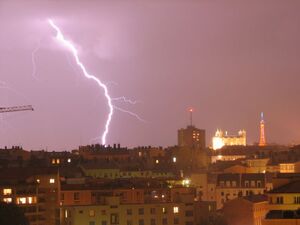
Lightning
| | | | | | |
This picture was taken at night with 15" exposure and F/4.5 aperture. As you can see the picture is too soft and too bright. I think a 10" exposure and maybe F/6.3 aperture would be better.
To shoot clash (lightning) I use a homemade script which is an intervalometer working only over 1". All sleeps time are defined in the script for all exposures between 1" and 15".
I need to work again for better shoots. I'd like to see yours.
This kind of shoot is typically a good way of working with scripts. A piece of luck is welcome.
- (See info below about using the motion-detection feature. so luck isn't so important anymore. :-) )
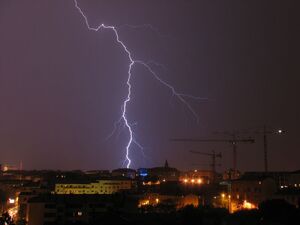 |
With the same script I did this shoot. The image is sharper because I used a faster exposure (8 seconds) and a smaller aperture with 6.3. I think the result is better but it's not enough.
I followed advice from the Dpreview forum. Good advice, thanks.
These shots taken using a S5IS running Motion Detect script by vk2him in Australia.
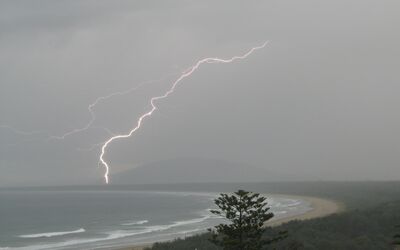
This was one of the first shots I took with CHDK and the motion detect script. I used the default setup in the script and left it running ... too easy!!!
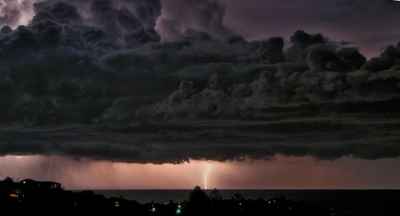
This shot was taken at night, I then processed it using some HDR software to give a more dramatic effect ..
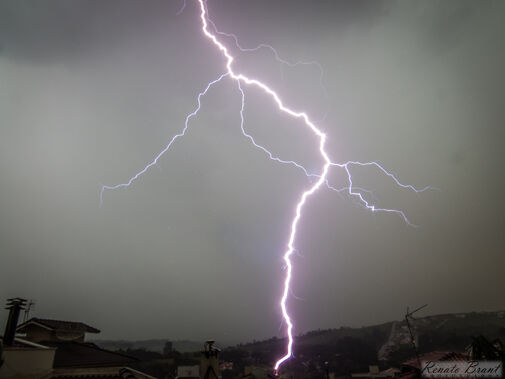
This shot was taken with an Canon SX50 HS
Exposure: 1/6sec f/8
Focal Length 4.3mm
ISO 80
Overall, capturing lightning is now very easy
Links
Other nice photos:
Lightning Photography done automatically with MX3's Motion Detection!
Taken with MX3's Motion Detection to trigger automatic shooting with lightning detection using a simple script. All lightning strikes are preceded by a leader-strike, the main strike(s) happening anywhere from 100-300 milliseconds after this leader-strike. While browsing the main CHDK Russian forums, I ran across these. Vitaly and others tested MX3's implementation of motion detection to see if it really was fast enough to capture lightning strikes. IT IS! [1] [2] [3]
And more -- [4] The 1st collection done with the usual manual method, tripping the shutter and waiting and hoping. The 2nd and 3rd collections were done automatically with a motion-detection script.
Now you can just set up the camera, run a simple motion detection script, then head back into the safety of shelter. Every one of your frames should have a lightning strike on it. No more risking your life while hoping that you might get one while keeping the shutter open! MX3, you may have just saved some lives (like mine)! :-) --GrAnd 14:12, 14 October 2007 (UTC)
- Could anyone that's used this method help answer some questions posed in the "Discussion" section for this page? THANKS! This is an amzing feature, but it would be nice to have the best script and settings available for it before heading out in a lightning-storm. :)
- There has been some excellent discussion concerning this issue lately. Apparently not all camera models are created equally when it comes to motion-detection speed and being fast enough to respond in time to lightning-strike behaviors.
- Please see this thread at the CHDK forum titled "Motion Detection Too Slow?" for further information. As well as many hints and tips on the best way to tweak and set values for the MD (motion-detection) scripts for speed. This thread also includes links to some fast-response sample images from MX3 himself (he can throw toys and have the camera capture an image of them before they even land, and for his next trick ... :-) ). But also extremely important, a member there by the name of jonnythe has written a small and simple program whereby you can emulate the pre-strike leader-flash of a lightning bolt to determine if your camera and script settings will be fast enough. Now you can test in advance if your camera, CHDK scripts, and methods will be ready for that once-in-a-lifetime thunderstorm when it finally happens. You can find his motion-detection speed testing program in this post in that thread.
Photo Examples using Motion Detection
For one of the more spectacular lightning shots taken with CHDK + Motion Detection, see this photo: Lightning at Cypemort Point. And the CHDK Forum thread discussing how it was taken: Lightning Shots.
Here's another spectacular lightning shot, posted in a thread at the CHDK forum: Hand-held Lightning Shot. It's not a spectacular lightning photo in and of itself, but this is one of the first times that any lightning has been shot hand-held. Due to CHDK motion-detection's extremely fast response time we are no longer limited to capture a lightning strike by keeping the shutter open for extended periods (or shooting hundred of photos in a row). Now you can capture lightning strikes in normal daylight conditions using normal shutter speeds. No longer are we burdened by having to use dense ND filters to cut down light levels to allow for slow shutter speeds in daylight storms. This may be the first time in history where this is now possible using an average consumer camera. That's why this hand-held lightning shot is spectacular. It ushers in a whole new era in photography. (As do many of CHDK's other amazing features.)
